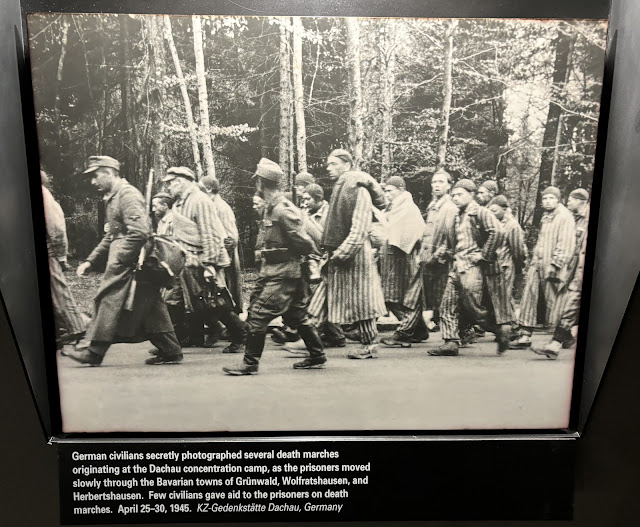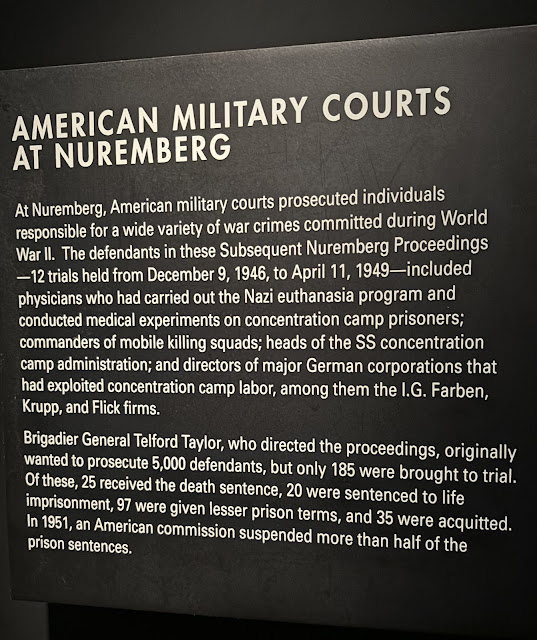The USHMM is the United States' official memorial to the Holocaust and provides for the documentation, study, and interpretation of Holocaust history. It is dedicated to helping leaders and citizens of the world confront hatred, prevent genocide, promote human dignity, and strengthen democracy.
Since its dedication in 1993, the museum has had nearly 40 million visitors, including more than 10 million school children, 99 heads of state, and more than 3,500 foreign officials from over 211 countries and territories. The museum's visitors have come from all over the world, and less than 10 percent are Jewish. In 2008, the website had 25 million visits, from an average of 100 countries, daily. Thirty-five percent of these visits were from outside the United States.
The USHMM's collections contain more than 12,750 artifacts, 49 million pages of archival documents, 85,000 historical photographs, a list of over 200,000 registered survivors and their families, 1,000 hours of archival footage, 93,000 library items, and 9,000 oral history testimonies. It has teacher fellows in every state in America and, since 1994, almost 400 university fellows from 26 countries.
After we entered, we got in line for the elevators to take us inside the museum.
It was nice to see young people there so that they can learn about history.
The artifacts, photos, and information is overwhelming......and heartbreaking.
I think we all know the story of Anne Frank. I watched the movie The Diary of Anne Frank many times as a child and laid in bed at night thinking the sirens in the distance were coming for me. I was always so relieved when I woke up in my very own bed the next morning.
Anne Frank was one of the more than one million Jewish children in Europe who died in the Holocaust. Born in Germany in 1929, she fled to Amsterdam with her family soon after Adolf Hitler came to power.
In May 1940, German troops invaded the Netherlands. The following year, Anne was forced to leave her school to attend a Jewish one. Soon thereafter, the Frank family began making preparations to go into hiding. In May 1942, Anne, along with other Jews in the Netherlands, was required to wear a yellow Star of David.
That summer, the deportations of Dutch Jews to German-occupied Poland began. On July 5, Anne's' sister Margot received a summons to report for "labor". The following day, the Frank family went into hiding. For more than two years, they lived with four friends in a secret annex behind her father's company warehouse at 263 Prinsengracht. German and Dutch security police, using information provided by an informer, raided the building and arrested the inhabitants on August 4, 1944.
The Franks were sent to the Westerbork transit camp and from there deported to Auschwitz on September 3. Less than two months later, Anne and Margot were transported to the Bergen-Belsen concentration camp in Germany.
Anne's mother, Edith, perished at Auschwitz in January, 1945. In March, Anne and Margot died from typhus at Bergen-Belsen, just weeks before the British army liberated the camp. Of the eight people who hid in the secret annex, only Anne's father, Otto, survived.
I remember when we were here before there was a display of thousands of hair brushes that had been confiscated from the prisoners. It really left an impression on me. But, apparently, the exhibit has been temporarily removed - I think I'm glad I didn't see it again.
These cobblestones originally paved a section of Chlodna Street that was located inside the Warsaw ghetto from November 1940 to December 1941. Another section of the same street was off limits to Jews, who had to cross over it on a wooden footbridge.
After arriving at the camp by train, those selected for immediate death were marched to the underground entrance of the gas chamber.
At first, prisoners were transferred by train, and even by boat. Evacuations by foot, which became known as death marches, began in the final stages of Germany's military collapse. Prisoners were forced to march, often hundreds of miles and in bitter cold, with little or no food, water, or rest. Any prisoner unable to keep up with the others was shot.
The first major death march was launched in July 1944, when more than 4,000 inmates of a camp set up on the ruins of the Warsaw ghetto were moved to Kutno, a distance of 81 miles. About one-fourth of them were killed on the way. The largest death marches took place in the winter of 1944-1945, when the Soviet army was liberating Poland. On January 18, 1945, about 60,000 prisoners were removed from Auschwitz; 15,000 died during the march.
Mass killings of prisoners often occurred before, during, or after marches. In one evacuation, 6,000 prisoners from several satellite camps in East Prussia were marched to the Baltic Sea coast, where they were shot.
"Yesterday we went to the War Crimes Trials at Dachau. We went up there (only about 12 miles) yesterday morning and stayed till 4 in the afternoon, and I must say it was the most interesting day I’ve ever spent in Europe. The trials concerned the Camp Mauthausen Concentration Center (Austria) and some 61 men are on trial for their lives. The tribunal consists of eight full colonels and one major general…quite a bit of brass for the ill-deserving Krauts. I was extremely surprised at the defense the US is giving them – they have a major and several captains representing their case, and although they put little heart in the cause, I think they should be praised for making American justice work. Prosecuting attorney for the US is a crafty, witty Lt Col Denson, who is working the case in his own manner. Naturally the entire proceedings must be spoken in German and English, with an expert interpreter translating every German statement to English and vice versa. Nevertheless, the trial moves on at a fairly speedy rate."





























I have no words. I have been here, Yad Vashem, many other museums and memorials, and to Theresienstadt and to Auschwitz. Each time is heartbreaking and shocking. How human beings can treat other human beings is just horrifying beyond words.
ReplyDeleteI was thinking about you as I was writing this.
Delete